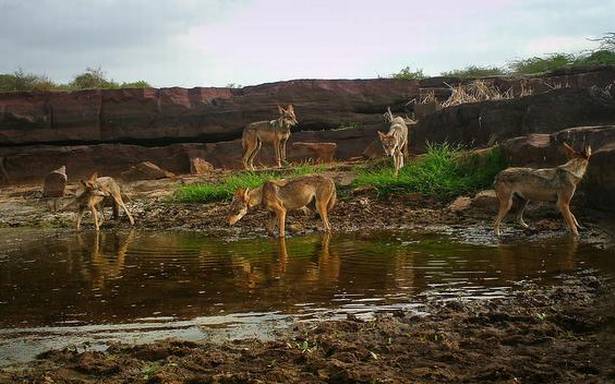Ranchers with a Brain
Uniquely, there is no culture of conflict between wolves and shepherds in these Koppal villages
The black soil rolls on for as far as the eye can see. In the distance, a herd of blackbuck grazing on a wilting groundnut crop stops and looks up nervously at our vehicle. In a flash they are gone, disappearing into the water channels that criss-cross the flat landscape.
I am in Sanganhal village in Karnataka’s Koppal district, where until recently, it was believed that larger fauna didn’t exist. Even now, for the forest department, the district is of little significance. Just over 5% of the geographical area is forest land, none of it declared protected area.
But in reality the district teems with wildlife. According to a Wildlife Conservation Society study that concluded earlier this month, there are striped hyena, wild bore, sloth bear and the occasional leopard. Less than a century ago, the Asiatic cheetah used to zip down Koppal’s plains. The animal is extinct now. And today, it is the wolf that is the apex predator that wanders across 86% of this land. And this canine is wildlife ‘hero’ for the Deccan Conservation Foundation. “I thought wolves disappeared in the 70s,” says founder Indrajit Ghorpade who had last seen one here as a child. And then in 2014, he spotted a majestic wolf on a mud embankment, and managed to get a shot of the animal: its triangular ears perked in rapt attention, its buff coat blending with the soil, its short tail limp. Inspired by the sighting, Ghorpade formed the foundation, determined to protect this species. A 2005 survey had estimated that just 25 wolves remained in Koppal.
The organisation reached out to villagers, set up camera traps, and in the next three years, helped prevent 12 instances of poaching and illegal quarrying.
Part of life
It helped that in Koppal wolves are an intrinsic part of cultural beliefs. Shepherds form one of the major pillars of the local economy, and they are unusually tolerant of these carnivores even though they often prey on their livestock, something that would have led to conflict elsewhere.
“One third of our flock is for god (losses through disease), one third is for us, and one-third is for wolves,” says Durganna. He lost a sheep to wolves just a few months ago. Wolves, he says, only eat the weakest of the flock, therefore determining natural selection and ensuring only the strong continue to breed. The presence of wolves, adds Durganna, “keeps sheep vigilant and healthy because they are constantly on the move.” Good muscle mass means that they fetch more in the market compared to their “lazier” counterparts from the “wolf-devoid” southern Karnataka.
“Such cultural attitudes made it easier to get people on our side,” says Ghorpade, who has now recruited a group of villagers to keep a close eye on the wildlife, much in the way a forest guard does. The paid information network is now more than six strong.
Project manager Vinay Shankar points to a pile of rocks by a vast line of windmills in Mandalmari village. “This den is where wolves nurse their young, after two months, they shift to another den,” he explains.
On the other side of the windmills is a dry channel, called twallahalla in Kannada, or ‘wolf stream’. The dense shrubs on its banks provide shelter to the wolves: 15 wolves in two packs have been camera-trapped here.
Enough for everyone
The foundation’s intervention has helped not just the wolves but other species too. In 2015, one peacock was spotted; by 2018, it was 20.
Grey francolin, a ground breeding bird once trapped for meat, can now be seen in significant numbers in the bushes. Striped hyenas, monitor lizards, palm civet, rusty spotted cat, jungle cat and ruddy mongoose have been captured on camera traps.
There is a cultural acceptance of the wolf’s wild prey base too — blackbuck, for instance.
“If there is a good crop, we don’t mind if blackbuck eat from our fields. There is enough for them and for us,” says Yamanur Saab, a groundnut farmer from Sanganhal.
It’s this culture of co-existence that makes the place ideally suited for wolf conservation, the foundation believes.
“If the tiger is the symbol of the Western Ghats, then wolves can be the symbol of Koppal,” says Ghorpode. All we need from the forest department is a plan to protect them from poaching and mining.
Source: There is no conflict between wolves and shepherds in these Koppal villages – The Hindu

